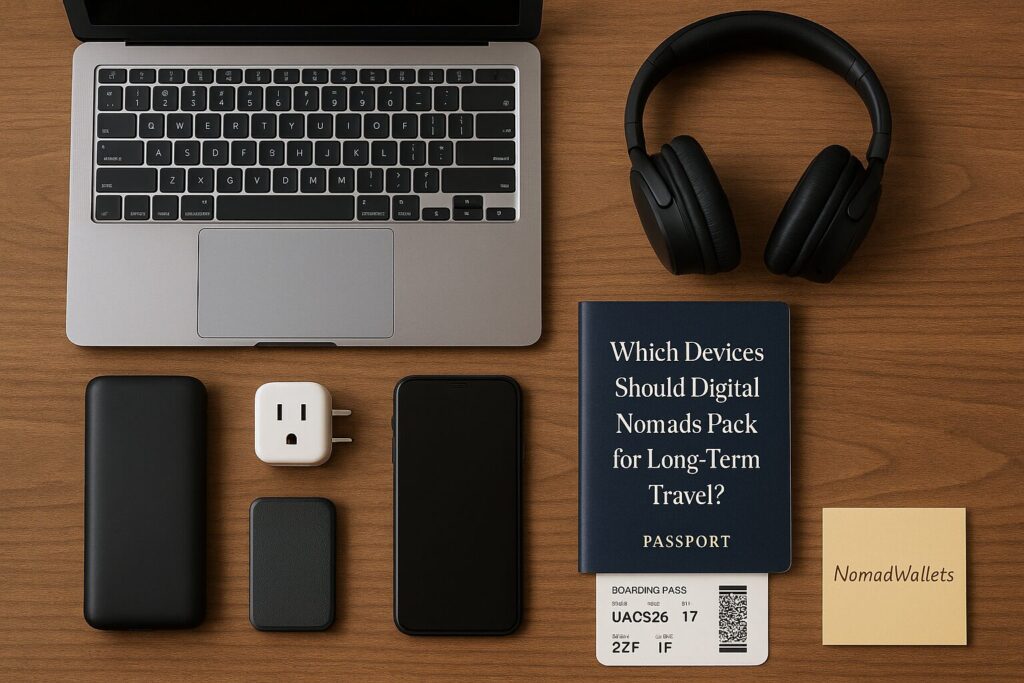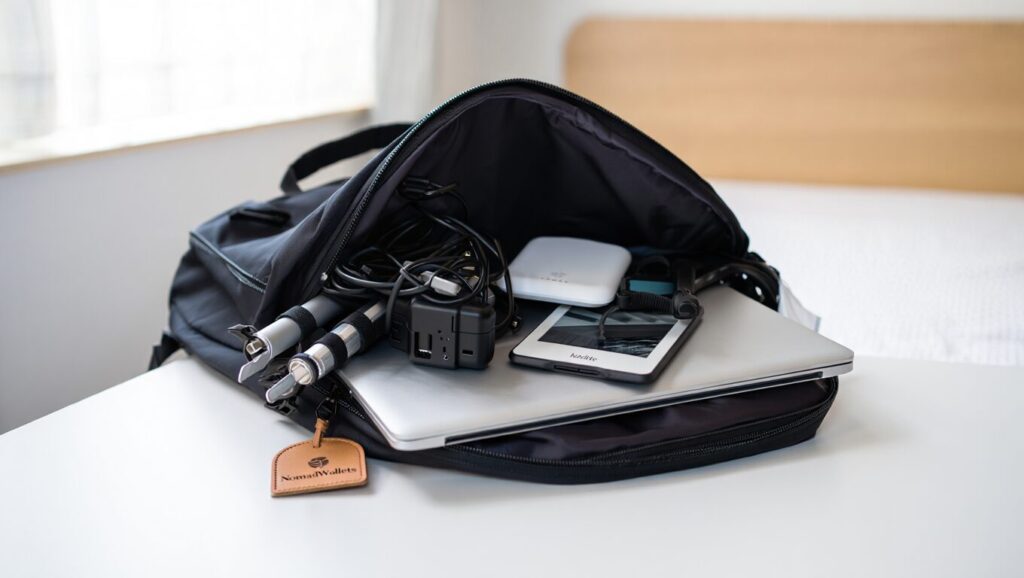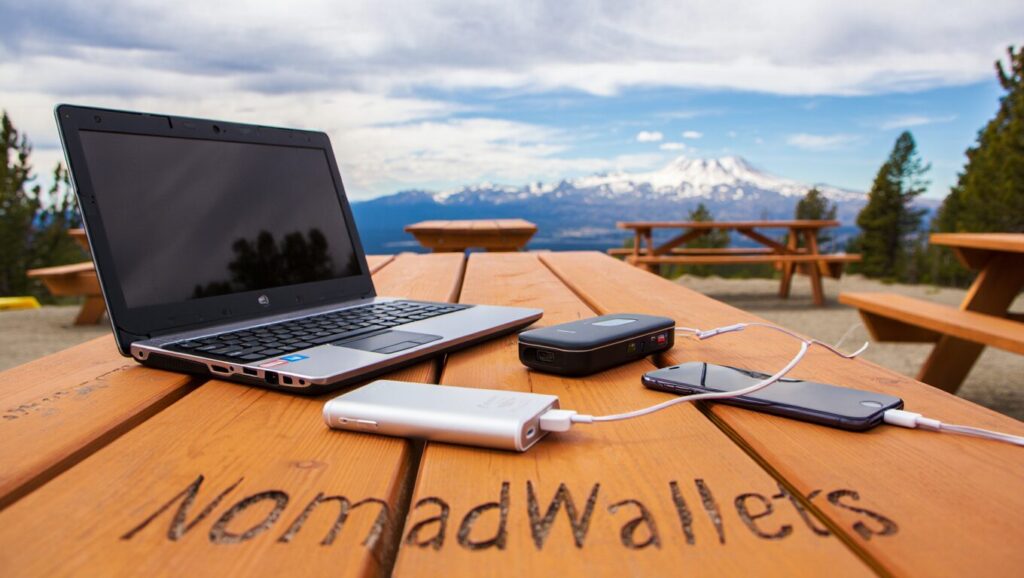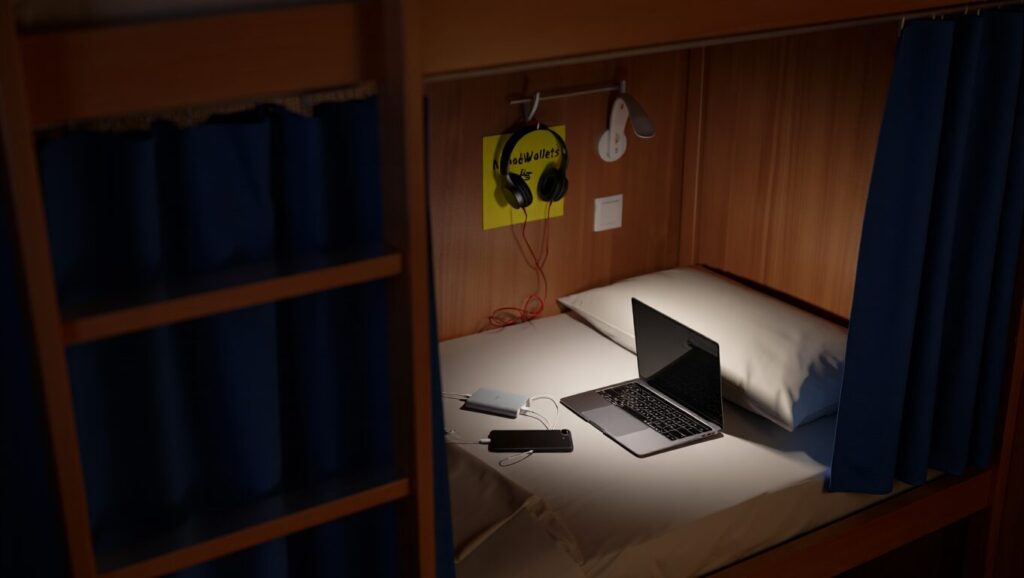
Introduction: Your Backpack Is Your Office
Let’s be honest—when you decide to live and work remotely, your gear isn’t just gear anymore. It’s your lifeline. Your entire workspace. Your link to income, clients, and home.
Packing the wrong tech can turn your dream trip into a productivity nightmare. But pack the right devices? You’ll feel like a superhero—laptop in one hand, passport in the other.
This isn’t a one-size-fits-all list, but if you’re wondering which devices for digital nomads need for long-term travel, this guide has you covered—from essentials to nice-to-haves.
1. Laptop – Your Digital Command Center
Let’s start with the obvious: your laptop is your mobile HQ. You’ll work from it, plan routes, pay taxes, attend meetings, and probably binge-watch something when you need to decompress.
What you need:
- Lightweight (under 3 lbs)
- 16GB RAM (minimum if you’re doing anything more than basic work)
- Solid battery (8+ hours)
- Global repair options
Top Picks
- MacBook Air M2: Fast, sleek, insanely long battery.
- Dell XPS 13: A solid PC option with premium build.
You’ll thank yourself for investing in a durable machine—especially when you’re miles from the nearest Apple store.

2. Smartphone – The Real MVP
Your smartphone will work harder than ever. It’ll double as your map, translator, hotspot, camera, bank, and yes—even your coworker sometimes.
Look for:
- Dual SIM or eSIM support
- Long battery life
- Reliable camera
- Water resistance if you’re going tropical
Top Picks
- 📷 Google Pixel 8: Crisp camera and a clean Android experience
- 🍏 iPhone 14: Great for creators and easy repairs globally
Tip: Install Airalo or Nomad eSIM before your flight. No more fumbling for SIM cards at airport kiosks.
3. Mobile Hotspot or SIM-Compatible Router
Hotel Wi-Fi can’t be trusted. And no one wants to upload a client file from a noisy café at 11 PM.
A portable Wi-Fi hotspot keeps you online when everything else fails.
Top Picks
- Skyroam Solis Lite
- TP-Link M7450
Perfect for rural towns, long bus rides, or when your Airbnb promises “fast Wi-Fi” but delivers dial-up vibes.

4. Power Bank – Your Safety Net
You’ll be on trains, planes, and tuk-tuks more than you think. A dead phone in a strange city? Not fun.
What to get:
- 20,000mAh or more
- USB-C PD for fast charging
- Compact enough for carry-on
Top Picks
- Anker PowerCore 20000 PD
- Zendure SuperMini
Bonus tip: Charge your power bank and devices every night—even if you think you won’t need it.
5. Universal Adapter (With Surge Protection!)
Outlets change with every country. And so do voltages.
Save yourself the headache and pack one adapter that works worldwide—and protects your gear.
Top Picks
- EPICKA Universal Adapter
- OneWorld PD Adapter
Surge protection might sound boring—until it saves your $1,000+ gear from a fried outlet in Southeast Asia.
6. Noise-Canceling Headphones or Earbuds
Trust me: buses honk, cafes buzz, and hostels… well, you’ll hear everything.
Noise-canceling gear will help you stay focused and sane.
Top Picks
- Sony WH-1000XM5: Gold standard for over-ear
- AirPods Pro 2: Compact and powerful for minimalists
White noise playlists are your new best friend. Especially on flights or in shared dorms.
7. Wireless Mouse + Compact Keyboard (Optional Comfort)
If you’re doing long sessions of writing, design, or spreadsheets, your wrists will thank you for upgrading your setup.
Top Picks
- Logitech MX Anywhere 3
- Keychron K3 (for tactile satisfaction)
You can build a makeshift standing desk with a chair, a trash bin, and your Bluetooth keyboard. Been there, done that.
8. Content Creation Gear (If That’s Your Thing)
If you vlog, freelance in media, or build content for socials, you’ll want better visuals than a shaky phone.
Top Picks
- Sony ZV-E10: Lightweight and YouTube-ready
- DJI Osmo Gimbal: Smoother videos with your phone
Add a mini tripod and lapel mic, and you’ve got a travel studio.
9. External SSD & Cloud Backup
Hard truth: tech fails. That’s why digital nomads double up.
Use:
- A rugged SSD for local backups
- Cloud storage (Dropbox, Drive, or Backblaze) for remote access
Top Picks
- Samsung T7 SSD
- Backblaze: Set-it-and-forget-it backup
Redundancy = peace of mind.
10. VPN App
Public Wi-Fi = public risk. A VPN secures your connection and keeps your data from prying eyes.
Top Picks
- Surfshark: Budget-friendly, unlimited devices
- NordVPN: Fast and trusted worldwide
Install on both phone and laptop before you leave your home country.
11. E-Reader (Optional but Lovely)
Perfect for long-haul flights, beach days, and winding down after screen-heavy work.
Top Pick
- Kindle Paperwhite
Lightweight, waterproof, and better than killing your laptop battery reading PDFs.
Bonus Tools (Small But Mighty)
- 🧲 Bluetooth Tracker (Tile or AirTag) – for your gear
- 🧼 Microfiber Cloth – greasy screens are annoying
- 🔌 USB-C Hub – especially for new laptops
- 🖼️ Webcam Cover – tiny privacy shield
- 🧰 Mini Toolkit – for quick tech fixes
Final Tips: Pack Smart, Not Heavy
Don’t take everything. You’ll regret it the first time you haul a 20kg bag up four flights in Lisbon.
Here’s what to remember:
- Invest in multi-functional gear
- Choose quality over quantity
- Think repairability and reliability
When you’re far from home, your devices for digital nomads become your job, your safety, and your sanity.

Frequently Asked Questions (FAQs)
Q1. What’s the most important device for digital nomads?
Your laptop is your main tool. But a reliable phone and power bank are right behind.
Q2. Do I need a VPN even if I’m careful online?
Yes! Public Wi-Fi isn’t safe. A VPN encrypts your connection and protects your data.
Q3. Is a tablet enough instead of a laptop?
Only for light tasks. If you code, design, or edit media, a full laptop is better.
Q4. What if my gear breaks abroad?
Have cloud backups, travel insurance, and research local repair shops ahead of time.
Q5. Should I bring all this tech from the start?
Nope. Start with the basics and upgrade as your needs evolve. You’ll figure it out faster than you think.
You May Also Like
- 101 Things That Happen When You Become a Digital Nomad
- The Digital Nomad Lifestyle: What It’s Really Like in 2025
Hi, I’m Tushar a digital nomad and the founder of NomadWallets.com. After years of working remotely and traveling across Asia and Europe, I started NomadWallets to help U.S. nomads confidently manage money, travel, banking, crypto, and taxes. My mission is to make complex financial topics simple, so you can focus on exploring the world and building true location freedom.
